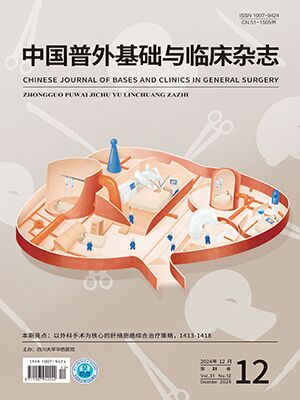| 1. |
Rawla P, Sunkara T, Gaduputi V. Epidemiology of pancreatic cancer: global trends, etiology and risk factors. World J Oncol, 2019, 10(1): 10-27.
|
| 2. |
Zhu H, Li T, Du Y, et al. Pancreatic cancer: challenges and opportunities. BMC Med, 2018, 16(1): 214.
|
| 3. |
Siegel RL, Miller KD, Jemal A. Cancer statistics, 2018. CA Cancer J Clin, 2018, 68(1): 7-30.
|
| 4. |
Liu X, Nie L, Zhang Y, et al. Actin cytoskeleton vulnerability to disulfide stress mediates disulfidptosis. Nat Cell Biol, 2023, 25(3): 404-414.
|
| 5. |
Wang Z, Du X, Lian W, et al. A novel disulfidptosis-associated expression pattern in breast cancer based on machine learning. Front Genet, 2023, 14: 1193944.
|
| 6. |
Meng Y, Chen X, Deng G. Disulfidptosis: a new form of regulated cell death for cancer treatment. Mol Biomed, 2023, 4(1): 18.
|
| 7. |
Feng Z, Zhao Q, Ding Y, et al. Identification a unique disulfidptosis classification regarding prognosis and immune landscapes in thyroid carcinoma and providing therapeutic strategies. J Cancer Res Clin Oncol, 2023. doi: 10.1007/s00432-023-05006-4.
|
| 8. |
Wang Y, Liu S, Yang Z, et al. Anti-PD-1/L1 lead-in before MAPK inhibitor combination maximizes antitumor immunity and efficacy. Cancer Cell, 2021, 39(10): 1375-1387.
|
| 9. |
Janssen J, Medema JP, Gootjes EC, et al. Mutant RAS and the tumor microenvironment as dual therapeutic targets for advanced colorectal cancer. Cancer Treat Rev, 2022, 109: 102433.
|
| 10. |
Sun L, Wang X, Saredy J, et al. Innate-adaptive immunity interplay and redox regulation in immune response. Redox Biol, 2020, 37: 101759.
|
| 11. |
Di Cara F, Savary S, Kovacs WJ, et al. The peroxisome: an up-and-coming organelle in immunometabolism. Trends Cell Biol, 2023, 33(1): 70-86.
|
| 12. |
Min HY, Lee HY. Oncogene-driven metabolic alterations in cancer. Biomol Ther (Seoul), 2018, 26(1): 45-56.
|
| 13. |
Wang H, Cheng Y, Mao C, et al. Emerging mechanisms and targeted therapy of ferroptosis in cancer. Mol Ther, 2021, 29(7): 2185-2208.
|
| 14. |
Hegde S, Krisnawan VE, Herzog BH, et al. Dendritic cell paucity leads to dysfunctional immune surveillance in pancreatic cancer. Cancer Cell, 2020, 37(3): 289-307.
|
| 15. |
Wu J, Cai J. Dilemma and challenge of immunotherapy for pancreatic cancer. Dig Dis Sci, 2021, 66(2): 359-368.
|
| 16. |
Leinwand J, Miller G. Regulation and modulation of antitumor immunity in pancreatic cancer. Nat Immunol, 2020, 21(10): 1152-1159.
|
| 17. |
Farhood B, Najafi M, Mortezaee K. CD8+ cytotoxic T lymphocytes in cancer immunotherapy: a review. J Cell Physiol, 2019, 234(6): 8509-8521.
|
| 18. |
Fincham R, Delvecchio FR, Goulart MR, et al. Natural killer cells in pancreatic cancer stroma. World J Gastroenterol, 2021, 27(24): 3483-3501.
|
| 19. |
Huang H, Wang Z, Zhang Y, et al. Mesothelial cell-derived antigen-presenting cancer-associated fibroblasts induce expansion of regulatory T cells in pancreatic cancer. Cancer Cell, 2022, 40(6): 656-673.
|
| 20. |
Jardim DL, Goodman A, de Melo GD, et al. The challenges of tumor mutational burden as an immunotherapy biomarker. Cancer Cell, 2021, 39(2): 154-173.
|
| 21. |
Huang R, Carbone DP, Li G, et al. Durable responders in advanced NSCLC with elevated TMB and treated with 1L immune checkpoint inhibitor: a real-world outcomes analysis. J Immunother Cancer, 2023, 11(1). doi: 10.1136/jitc-2022-005801.
|
| 22. |
Luo J. KRAS mutation in pancreatic cancer. Semin Oncol, 2021, 48(1): 10-18.
|
| 23. |
Chauveau C, Rowell J, Ferreiro A. A rising titan: TTN review and mutation update. Hum Mutat, 2014, 35(9): 1046-1059.
|
| 24. |
Yang N, Tian J, Wang X, et al. A functional variant in TNXB promoter associates with the risk of esophageal squamous-cell carcinoma. Mol Carcinog, 2020, 59(4): 439-446.
|
| 25. |
Robinson R, Carpenter D, Shaw MA, et al. Mutations in RYR1 in malignant hyperthermia and central core disease. Hum Mutat, 2006, 27(10): 977-989.
|
| 26. |
Matissek SJ, Elsawa SF. GLI3: a mediator of genetic diseases, development and cancer. Cell Commun Signal, 2020, 18(1): 54.
|




